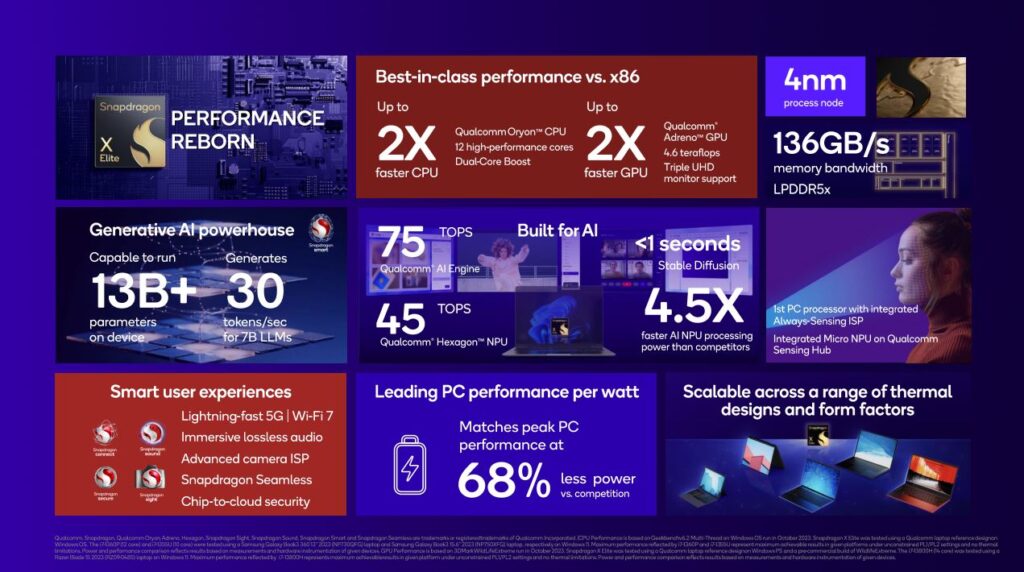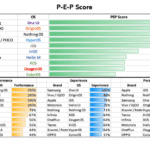AI powered smart devices to create an aura of contextual computing taking personal computing to the next level of personified computing. My takeaway from the Snapdragon Huawei Summit 2023.
Qualcomm recently held its annual flagship Snapdragon Summit. As a keen technology watcher, I look forward to this summit to hear the latest from Qualcomm. For some years now Qualcomm has been announcing its flagship Snapdragon 8 platform upgrades along with some key announcements. This year as well it made a host of announcements. Let’s know more about them before I talk about the implications on the industry. In all Qualcomm made 4 announcements.
Snapdragon X Elite

Finally, it seems Qualcomm has made it to the world of personal computing beyond smartphones. With the announcement of Snapdragon X Elite, it has introduced its very powerful chipset for laptops. This 4nm process node based SoC is an AI first chipset. The Oryon CPU is based on 12 high-performance cores at a clock speed of 3.8 GHz, it can boost the power with dual-core 4.3 GHz. The architecture can support 136 GB/s memory bandwidth with 42MB total cache. The company claims its peak multi-threaded performance 50% faster than the competition M2 chip from Apple. To support ultra immersive graphics, it has an Adreno GPU that can go up to 4.6 TFLOPS. This supports 4K with 120Hz HDR10 display.
Well, the CPU and GPU in this SoC is for a phenomenal experience. But that’s not all. X Elite is powered by Hexagon NPU with an AI Engine peaking 75 TOPS. In terms of Generative AI, it can run 13B parameters on the device. This takes edge computing to another edge!
Needless to add that it is loaded with all the latest generation of connectivity like Wi-Fi 7. The company also claims that the per watt performance of the PC consumes 68% less power versus the competition against which it is benchmarked.
The processing capabilities that are enhanced by the AI powerhouse built by Qualcomm in Snapdragon X Elite SoC is going to bring an ultra-premium experience in laptops. This is going to substantially benefit Windows to be able to jointly create Mac equivalent or better experiences for users who buy laptops from different OEMs based on Windows OS.
In a way Qualcomm has taken a different route in the PC computing this time where it has created a superior offering than Intel and has its chipset in direct competition with Apple’s M silicon. This is a detour in its strategy as in the earlier avatar Qualcomm was focusing on the affordable laptop segment with its some of the introductions in 2018-2019 timeframe.
Snapdragon 8 Gen 3

This upgrade to its flagship smartphone chipset is immersed with AI capabilities and the features that will further elate the performance making it an ultra-immersive experience for users. The 8 Gen 3 will allow users to create and play with content leveraging AI capabilities helping them generate very professional grade content. The SoC capabilities will allow OEMs to create personal buddies for users which will assist them in a host of applications including content management in a content format agnostic way.
Qualcomm announced AI assistant integration with 8 Gen 3 based on Meta’s Llama 2 LLM model offering a complete on-device private AI powerhouse. It will be capable of processing 10B+ parameters at an exceptionally great speed of 15 Tokens / sec. This will be an incomplete experience without complementing memory capabilities. For this Qualcomm AI stack on the SoC supports LP-DDR5x with 4.8GHz speed making it the fastest on-device memory at the moment.
Qualcomm’s AI Engine on the chipset comprises of Adreno GPU, Hexagon NPU, Sensing Hub, Kryo CPU and the Memory specifically designed to process AI powered features and functions. Meta’s Llama 2 LLM model will be processed by the Hexagon NPU, while Sensing Hub and Kryo CPU will be respectively leveraged for front-end Whisper and Open-source TTS output respectively.
Qualcomm has also equipped 8 Gen 3 with Qualcomm AI Stack Models which already supports 20 models at the launch time. This means OEMs can implement AI almost for every type of content and applications.
Other areas of improvement than the previous generation of chipset include gaming, video and image processing, audio and security features.
In many ways we can say that Apple and Google already pioneered NPU into smartphones through their custom silicon, and now the pure play fabless chip makers like Qualcomm and MediaTek are also making their AI first chipsets for smartphones. So far we have seen very basic implementations of AI in the smartphones without any edge capabilities. Now with 8 Gen 3 platform we will witness a lot more personified edge computing on smartphones as well.
Snapdragon Seamless
The third interesting announcement was the introduction of Snapdragon Seamless which is for enabling linkages across a host of devices using different operating systems. Seamless will help in easy discovery and information sharing across various devices based on Android and Windows operating systems. This is an interesting addition from Qualcomm starting this year that will help OEMs, especially from the smartphone space to develop an ecosystem, something that many of them have already implemented to give an Apple like experience. This also goes with the trend of connectedness, an aura within which the present consumers live and elate their lifestyle.
Finally, Qualcomm also introduced S7 and S7 Pro Gen 1 sound platforms with on-device AI capabilities to deliver personalised, responsive and immersive audio experiences which are becoming increasingly helpful for users for consuming and creating content in the audio format. Even for a holistic video experience, we need complementing audio capabilities.
Conclusion
Across the summit and through the range of products announced and the vision shared by Qualcomm along with other partners like Microsoft and Meta, this is the new era of computing. The era which is powered by AI making edge computing a reality. This edge computing is extremely empowered making it possible for the OEMs to create a never before experience of on device AI. With these powerful technologies, the computing devices like smartphones, laptops, wearables and others will be able to contextualise the environment in which a user is and personalise the computing experiences. This means no two devices will be same, even if the brand, model and variant, including the colour remain identical. The device will have all other elements just personified as per the users. This is the era of Personified Computing, signing off from the long journey of Personal Computers which has revolutionised the world we live in.






2 responses to “Welcome to Computing Personified!”
[…] today announced the latest family of M3 processors and recently Qualcomm announced Snapdragon X Elite. This is a paradigm shift in the chipset industry for personal computing devices. MediaTek the […]
[…] it a flagship smartphone not with the flagship chipset. Just after its launch, Qualcomm announced Snapdragon 8 Gen 3, which will make buyers dubious whether they should buy OnePlus Open now which does not have the […]